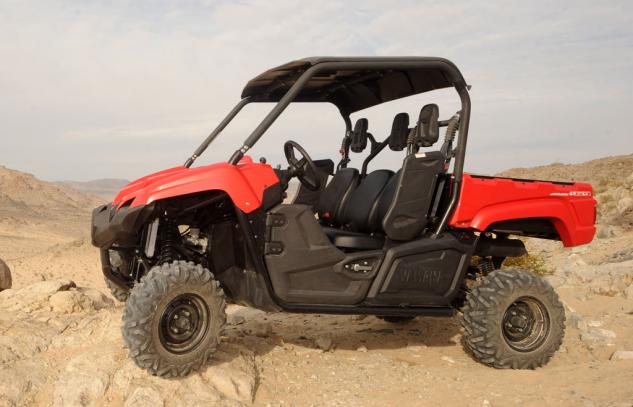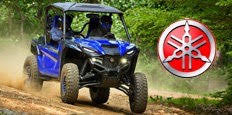2014 Yamaha Viking 700 Review - Desert Test
Sometimes we can gain a new appreciation for a particular item in our lives when we find uses for it beyond those for which it was intended. While Yamaha’s new-for-2014 Viking 700 is certainly built to withstand the rigors of working at the ranch or on the farm, there will inevitably come a time in just about every Viking’s life when concerns for towing capability and cargo capacity are thrown to the wind in favor of good old-fashioned, Hooowee!-style fun.
Visit the Yamaha Viking Forum
That was our mission this year when we procured a non EPS-equipped Viking 700 for photo chase work and after-hours play at the King of the Hammers ultra 4×4 race in Southern California’s Mojave Desert. Our test rig was subjected to a solid week’s worth of Baja-style butt-kicking over the Johnson Valley OHV Park’s diverse desert terrain, which included trails with trophy truck-sized whoops, dunes-style sandy hills. And rocks—not just the occasional rock here and there, but wheel-bending, “I’m gonna tear your underbelly to shreds,” jagged rocks. We also found the occasional boulder to scale.
We brought a non EPS-equipped Viking 700 out to the Mojave Desert for a week of work and play at the King of the Hammers.
Needless to say, we were confident that our test site and our accelerated test method – basically, we drove it like we stole it – would expose any immediate flaws in the Viking 700 if there were any to be found.
Heart of a Rhino
In case you’ve been living under one of the rocks that crowd the Mojave Desert landscape, you know that the Viking 700 was announced in June of last year to replace Yamaha’s much-loved Rhino, a machine that effectively grandfathered the sport UTV movement even though it wasn’t originally designed with high-speed ditch-bashing in mind. The Viking 700 builds on the Rhino’s workhorse legacy with a wide and spacious new three-seat cockpit and a generous, tilting cargo bed with 600 pounds of carrying capacity. The Viking can also tow 1500 pounds via its two-inch receiver hitch.
COMPARISON: Read our review of the 2014 Yamha Viking 700 EPS
Yeah, whatever. We’ll leave the work to folks with real jobs. We tend not to pull trailers when we’re boonie-bouncing, and the only hauling we were concerned about in the desert was hauling ass.
While the Viking is a worker at heart, we aimed to find out how much it liked to play.
Fortunately, the Viking has plenty of oomph for that. It is powered by Yamaha’s tried-and-true liquid-cooled, fuel-injected, SOHC, four-valve single-cylinder engine. Yamaha claims this is the brawniest version yet. With a 10.0:1 compression ratio and an oversquare 102mm x 84mm bore and stroke, the 686cc single channels quick-revving power through a centrifugal clutch to Yamaha’s proprietary Ultramatic dual range (high/low) transmission, which is designed to keep its V-belt under tension regardless of engine rpm or load. Yamaha calls it a dual-action system and says that it greatly increases belt life. The transmission is also set up to induce engine braking across the entire rev range, helping to slow the Viking on steep downhills during off-throttle coasting.
Our desert raids proved that the Viking can definitely get up and go. It exhibits clean acceleration and excellent throttle response from zero to its engine-governed 50 mph top speed. Obviously tuned for ranch work, the Viking is no screamer, favoring low-end punch and a strong midrange that flattens out at higher rpm. That works just fine for grunting over rocks or when powering out of a sandy corner, but its slightly thinner top-end meant that the Viking gave up a yard or two to a more sport-oriented, V-Twin-powered UTV that we also had on hand when drag racing across dry lakebeds.
Yamaha’s 686cc single provides plenty of low-end power, but at high speeds it produces some noticeable vibration.
The lack of top-end power was to be expected, but our real gripe with the Viking engine is that it vibrates too much, sending far too many tingles through the chassis and cab for our tastes. Yamaha’s engineers could stand to reduce some of the “thump” in the Viking’s thumper motor.
COMPARISON: Read our review of the 2014 Kawasaki Teryx LE
But the rest of the Viking’s drive train was smooth as silk regardless of how much we tried to abuse it. The transmission’s gate-style shifter has a sturdy, positive feel, and going from two-wheel drive to four-wheel drive or fully locked differential four-wheel drive is as simple as rotating the dash-mounted knob that controls the Viking’s three-position On-Command 4WD system. Nothing tricky here, just simple efficiency.
A Chassis for Bales or Trails
The Viking’s engine is housed in an all-new ROPS-certified steel chassis with a sturdy roll bar in the rare (we hope) event that one should find itself wheels-up. Suspension chores are handled by front and rear independent double wishbones with coil-over shocks providing 8.1 inches of travel to all four corners, and front and rear sway bars help keep the 84.1-inch wheelbase UTV tracking straight and true while also minimizing body roll in the corners.
The Viking’s suspension quality is surprisingly good. Its shocks are clearly valved for ranch work and don’t deliver the plushness that a good set of aftermarket off-road units will, but we were still impressed with them. In fact, when pounding through the whoops at high speed, about the only extra feature we wished for was more travel – as in about two more inches worth. C’est la vie.
The Viking’s front and rear dual hydraulic disc brakes are nothing short of amazing, though – maybe the best we’ve ever experienced on a UTV. Strong and powerful, they can haul the 1,342-pound Viking to a stop in rapid fashion on solid terrain, but we also appreciate how linear they are when traction conditions are less than optimum, such as in sand or on slick hardpacked trails. A lot of other UTV manufacturers wish their brakes were as good as the Viking’s.
Kudos to Yamaha for outfitting the Viking with possibly the best brakes we’ve ever seen on a stock UTV.
The Viking’s stiff chassis behaves very well in all sorts of rough conditions, fast or slow, with a quick-steering yet solid feel. We also appreciate its 11.8 inches of ground clearance, which we tested on several occasions. Fortunately, the Viking’s steel skid plate bore the brunt of our abuse without even a whimper.
But some of our testers found issue with the Viking’s tendency to exhibit a weird feedback through the steering wheel when bumps or rocks were encountered on the trail. Granted, we didn’t have the EPS-equipped Viking, so we expected the steering feedback to be livelier with the manual-steer model at speed, but this sensation was almost as if the Viking was telegraphing that it was going to sway off line. The condition was easy to correct when it happened, but whenever one guy would mention it, he would have another guy would jump in with him and head down the trail only to fail to repeat the symptom. It didn’t take long to figure out that the Viking really likes to have its suspension loaded evenly, and aggressive driving tends to affect its steering slightly when driven solo. It’s more of an odd feeling that requires getting used to than a real annoyance, and it is most definitely not a safety concern, in our opinion.
We found the Viking offered more responsive handling with a driver and at least one passenger.
Otherwise, the Viking handles about like we expected it would. Despite that weird steering sensation, its suspension sway bars actually do keep it rolling straight and true in the rough, and its wide track, which is actually optimized for proper spacing of the wheels between planting rows, helps the Viking stay planted on all four wheels during aggressive cornering. We did manage to pull off one Dukes of Hazzard-style two wheel tip in the sand when pushing the vehicle to the absolute limit during our photo shoot, but the Viking’s wide track may have helped to avert a tipover. Thanks to the engine’s low-end grunt, steering with the throttle is also easy, as the chassis’ feedback helps the driver to predict when the Viking’s wheels are breaking traction and adjust accordingly.
COMPARISON: Read our review of the 2013 Polaris Ranger XP 900 with Video
We had no issues with Viking’s steering per se, even though it wasn’t the EPS version. That said, we would probably just go ahead and spring the extra $1000 for EPS. As precise as the Viking’s manual steering is, it’s also old-school. The new electronic steering systems are simply awesome and, in addition to their feather-like steering feel, they also help to damp steering feedback to the driver, who is then less likely to overcorrect.
Please Be Seated
Now a few words about the Viking’s unconventional three-person cockpit: All of our testers loved it. Even with three grown male adults aboard, the Viking offers plenty of upper torso and leg room, and Yamaha deserves credit for paying attention to the details. They did this in two ways: 1) The seating offers an adjustable driver’s seat, and the middle seat is set back five degrees to effectively offset each passenger’s shoulders and eliminate any claustrophobic feel; 2) Mounting the engine under the bed rather than in the middle of the chassis allows a pass-through floor design for excellent legroom and easy entry and exit from either side of the vehicle.
Even with three adults on board, all our testers came away impressed with the Viking’s surprisingly roomy cockpit.
Once inside, all occupants are securely held in place in comfortable bucket seats by the Viking’s three-point seat belt. All three seating positions feature separate padded headrest and the passengers have the option of hanging on to an adjustable dash-mounted handhold for additional security. It’s a welcome safety feature, but as much as we like it, we absolutely love the rotomolded shoulder bolsters that ensure that the driver’s or passenger’s shoulder will be isolated from direct contact with the ground if the Viking should tip on its side. That’s just plain common sense, and we’ll take ‘em even if the black bolsters do look a little hokey from a styling standpoint. At least they match the Viking’s doors.
Monitoring engine and transmission function is accomplished via an easy-to-read digital LCD instrument panel. Its features include a large digital speedometer, odometer, dual tripmeter, hour meter, 4WD status, transmission position, clock and fuel gauge. There’s nothing there that you don’t need. The LCD panel is backlit, which also makes it easy to read when driving at night.
Actually, we could have sworn that the LCD was throwing out more light than the Viking’s anemic headlights. They cast a sallow that is a far cry from LED headlights. The first update made to the 2015 Viking should be LED headlights!
If we owned the Viking 700, our first upgrade would be LED headlights.
Yet despite that glitch, The Viking abounds with other carefully executed details, such as a specially designed drive system air intake that helps prevent overheating and assists in keeping water and debris from entering the drive case; a convenient dash-mounted parking brake lever; a stamped steel dump bed that features four standard tie-down hooks; and a latch system that allows the cargo bed to be tilted from either side of the vehicle. We also like the Viking’s tool-free air filter, latching glovebox (a lockable box would be even better) and four in-dash cup holders—although, had we tried to use them, our riding gear would’ve looked like we crashed headlong into a Starbucks. Speaking of “fuel,” the Viking holds a substantial 9.7 gallons of gasoline, and its efficient EFI means that you’ll be able to go a long, long way between fill-ups.
COMPARISON: Read our review of the 2014 Kubota RTV X-Series
Our Viking 700 was delivered in Red and featured Yamaha’s accessory Suntop, a welcome addition, for a total MSRP of $11,799. Every new Viking also comes with a six-month limited factory warranty.
Winning Play
At the end of the week, all we could do is admire the Yamaha Viking 700. This work-oriented UTV wasn’t really designed to tame the desert, but that didn’t stop it from holding its own in the presence of more sport-oriented rigs. We wouldn’t hesitate to beat on it again because we know that it can take the punishment. The Viking 700 does, indeed, play as hard as it works.
More by Scott Rousseau



































